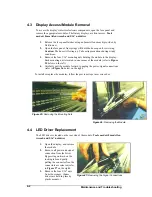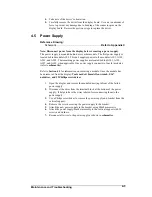
3. Phoenix
ä
-Style Connectors:
Figure 12:
Phoenix-
Style
Connector
Phoenix-style connectors, which are usually green, are often
used for signal termination on circuit boards. Refer to
Figure
12
on the right. Strip one-quarter inch of insulation from the
wire prior to termination. To remove a wire, turn the above
screw counter-clockwise to loosen the connector's grip on the
wire. To insert a wire, push the bare wire into the connector,
and turn the above screw clockwise to lock the wire into
place.
4. Mate-n-Lok
ä
Connectors:
The Mate-n-Lok connectors found in the signs are white and
come in a variety of sizes.
Figure 13
on the right illustrates a
four-pin Mate-n-Lok connector. To remove the plug form the
jack, squeeze the plastic locking clasps on the side of the
plug and pull it from the jack.
Figure 13:
Mate-n-
Lok Connector
5. Phone Jacks (RJ11/RJ45 Connectors):
RJ connectors are similar to the telephone connectors found
in homes and are used on the ends of RJ11 or RJ45 cable. In
order to remove this plug from the jack, depress the small
clip on the underside of the plug. Before replacing an RJ
connector, spray it with DeoxIT
™
contact cleaner to remove
any foreign matter that may cause signal problems. In
addition, apply a generous amount of CaiLube
™
protector
paste to the plug before inserting it into the jack. This paste
will protect both the plug and the jack from corrosion.
3.2 Control Cable Categories
The conductor connector used in the network is an industry standard,
6-pin RJ11. This connector can be found on
many telephones and LANs.
Figure 14:
6-Conductor RJ11 Connector and
Cable
The cable used in the network is a standard flat
six-conductor telephone cable (standard flipped
cable). Refer to
Figure 14
on the right. This
cable has one end that is the mirror image of the
other end (i.e. the cable is flipped). Refer to
Figure 15
on the following page
for a standard
flipped cable.
Electrical Installation
3-2
















































